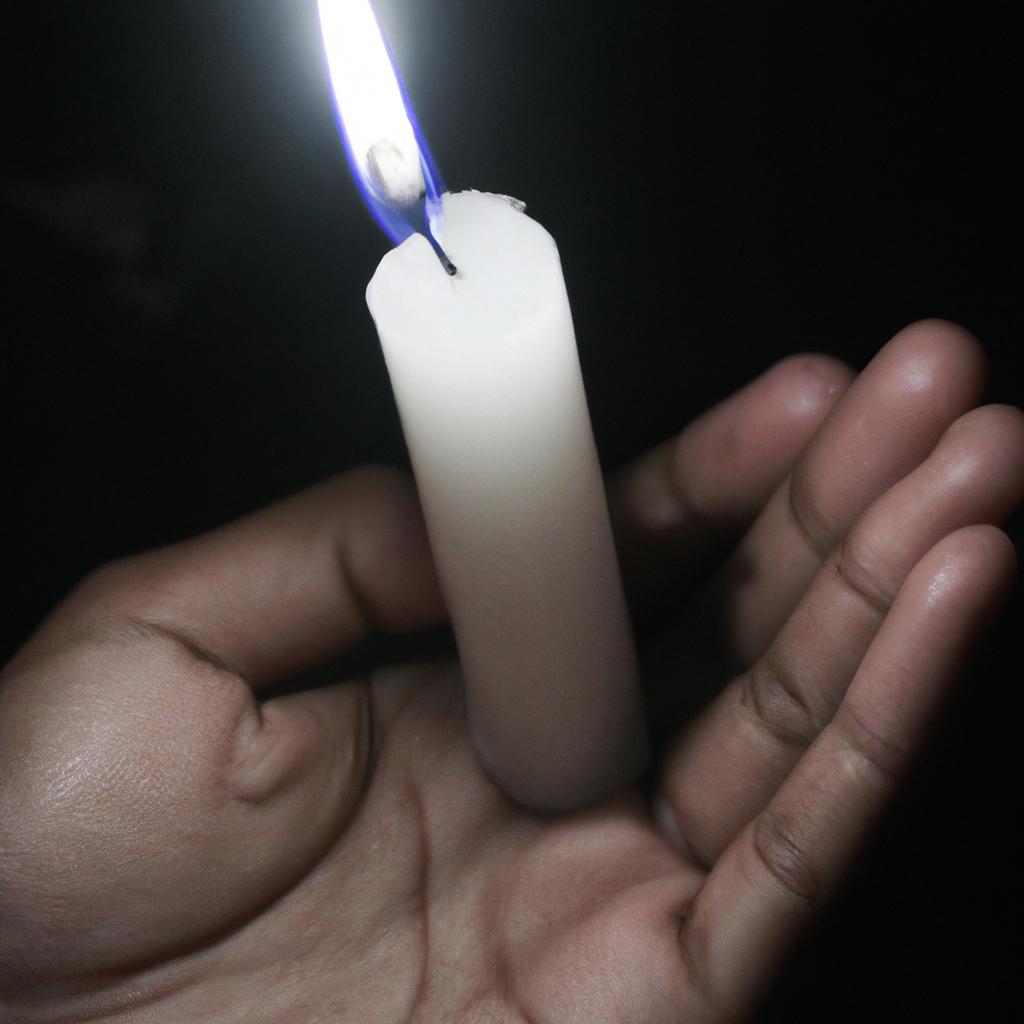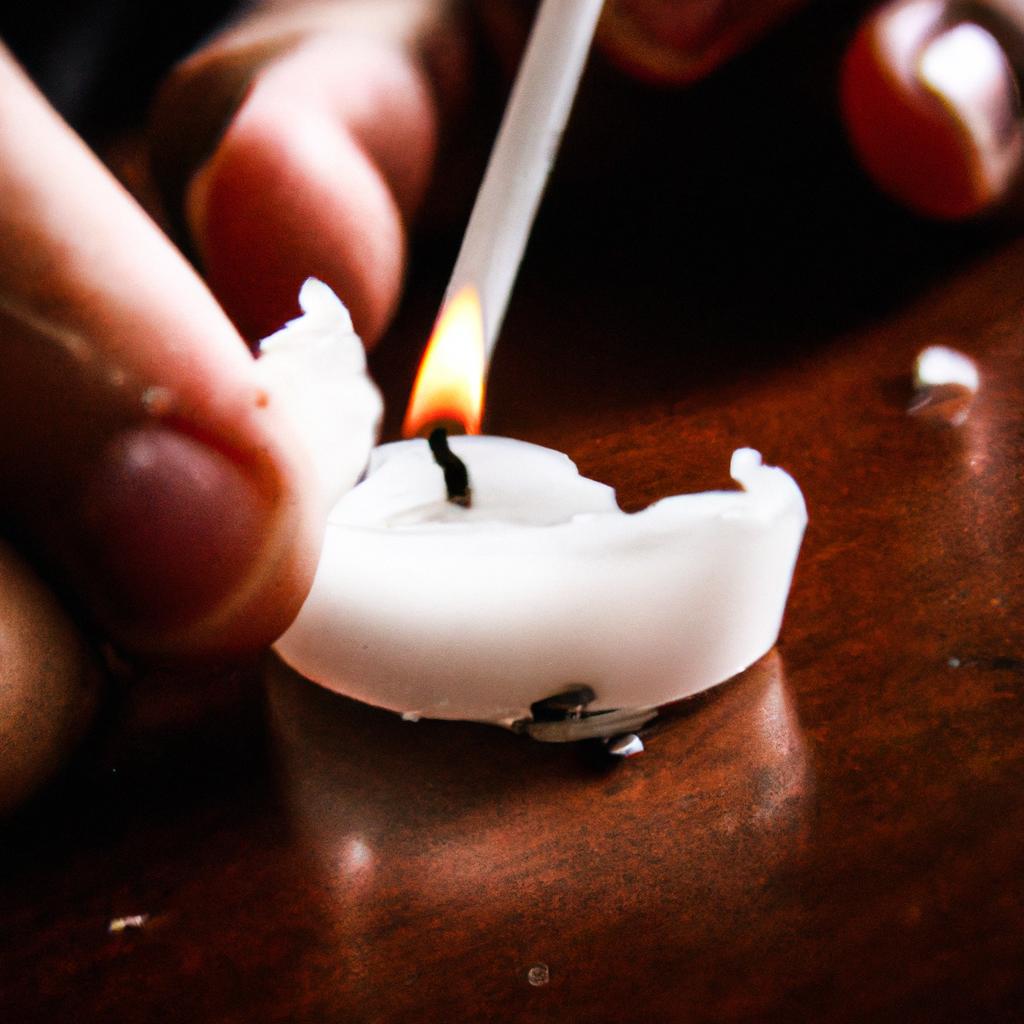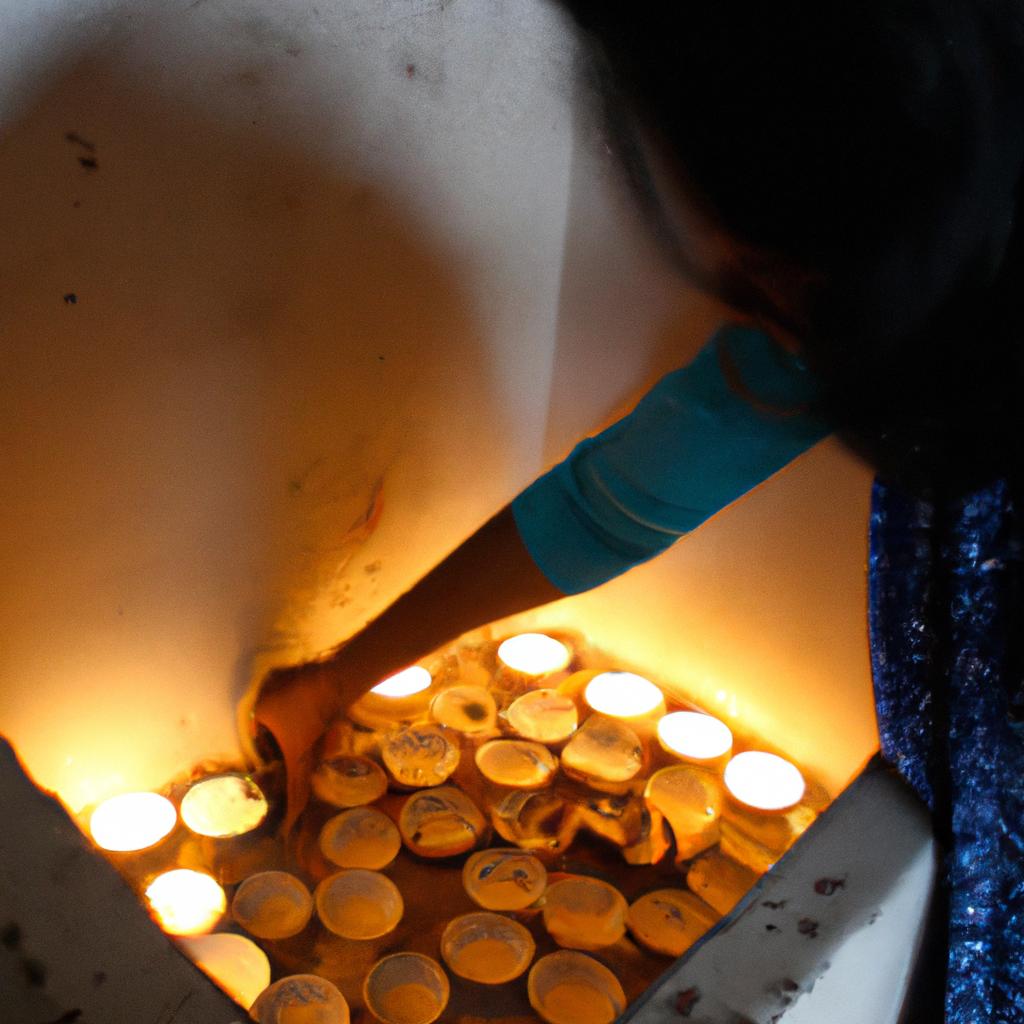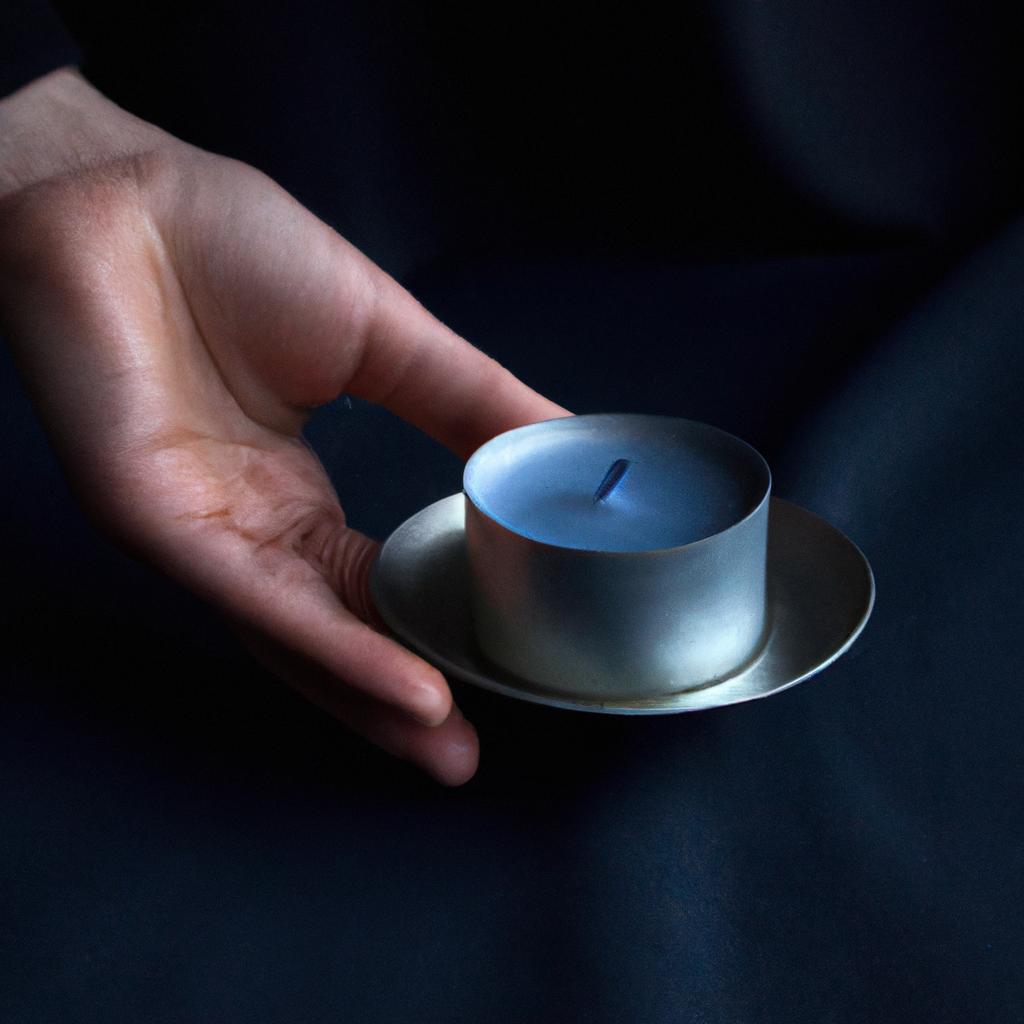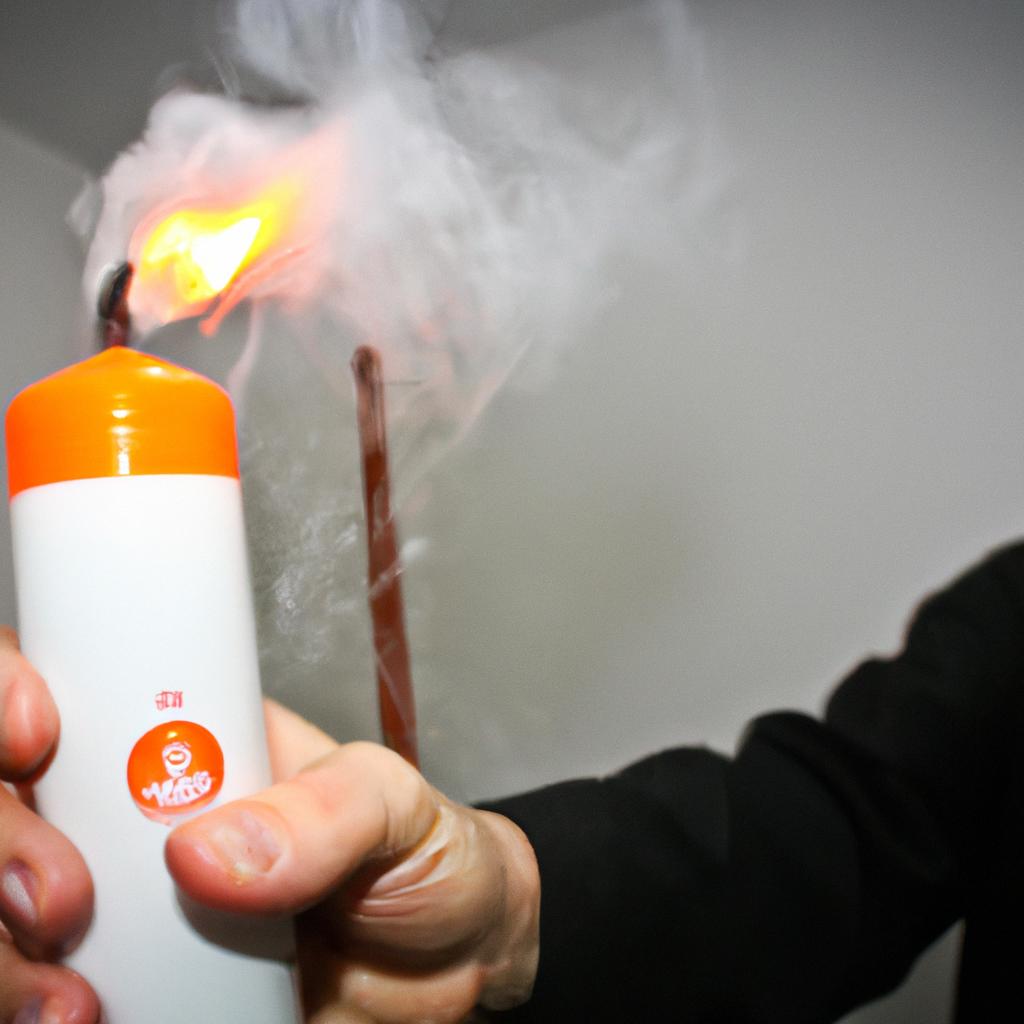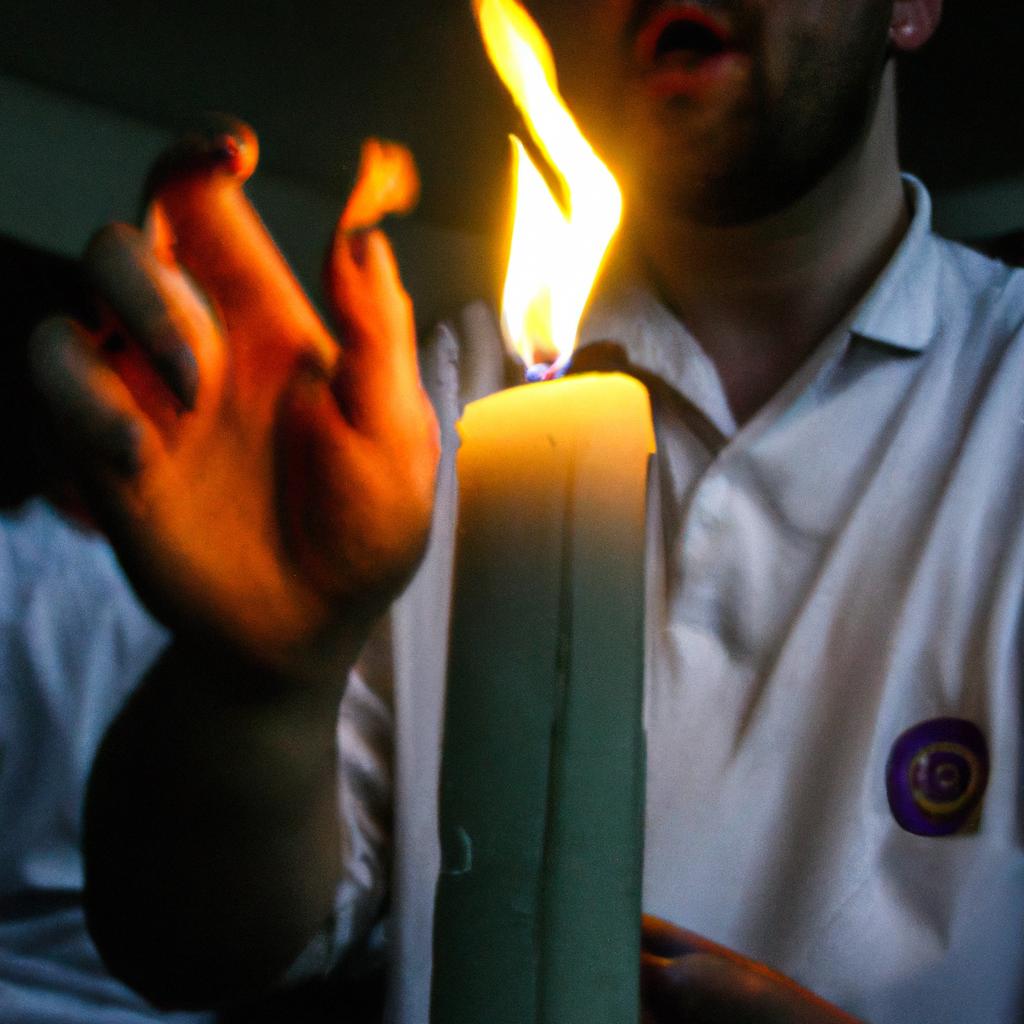Candle Safety: Ensuring Safe Practices in Candle Making

Candles have long been a popular choice for adding ambiance and warmth to our living spaces. However, the beauty of flickering candlelight comes with its own set of risks. According to the National Fire Protection Association (NFPA), an average of 21 home fires per day in the United States are caused by candles, resulting in numerous injuries and even fatalities. This alarming statistic highlights the importance of practicing safe techniques when engaging in candle making.
In a recent case study conducted by the Consumer Product Safety Commission (CPSC), it was found that a homemade scented candle caused a devastating fire in a residential property due to improper handling and lack of safety precautions. The homeowner had attempted to create their own scented candle using wax flakes and essential oils without following any specific guidelines or safety measures. As a result, the mixture became overheated during melting, leading to an uncontrollable flame that quickly engulfed the surrounding area. This unfortunate incident emphasizes the need for individuals involved in candle making to be well-informed about proper procedures and adhere strictly to established safety protocols.
General Safety Tips
Candle Safety: Ensuring Safe Practices in Candle Making
Imagine a scenario where you have just finished making a beautiful scented candle. Excited to light it up and enjoy the warm glow, you place it on a wooden table without considering the potential risks involved. Unfortunately, within minutes, the candle falls over and ignites a fire that quickly engulfs your beloved belongings. This situation could have been avoided if proper safety measures had been followed during candle making. In this section, we will discuss some General Safety Tips to ensure safe practices in candle making.
Safety Measures:
To begin with, let us consider four essential safety tips that every candle maker should keep in mind:
-
Use appropriate materials: Always choose high-quality wax, wicks, fragrance oils, and dyes from reputable suppliers. Poor quality materials can lead to uneven burning or even dangerous flames.
-
Work in a well-ventilated area: The fumes emitted during the melting process can be harmful when inhaled continuously. Ensure good airflow while working with melting wax by opening windows or using fans.
-
Maintain cleanliness and organization: Keep your workspace tidy and free of clutter to minimize accidents such as tripping or knocking over containers of hot wax.
-
Never leave candles unattended: It only takes a moment for an unattended flame to cause significant damage or injury. Make sure someone is always present when candles are lit.
In addition to these tips, referring to the following table will help reinforce the importance of adhering to safe practices:
| Potential Risk | Consequences | Preventive Measures |
|---|---|---|
| Placing candles near flammable | Fire hazard | Keep candles away from curtains, furniture, |
| objects | bedding material |
| Using unsuitable holders | Breakage leading to fires | Choose appropriate holders made of non- |
| | flammable materials |
| Failure to trim wicks | Excessive soot and smoke | Trim wicks to ¼ inch before burning |
| Ignoring candle burn time | Overheating, leading to accidents | Follow recommended burn times stated by the |
| | manufacturer |
In conclusion, practicing general safety measures is crucial when engaging in candle making. By using high-quality materials, working in well-ventilated areas, maintaining cleanliness, and never leaving candles unattended, you can significantly reduce the risk of accidents or fires. Additionally, referring to the provided table reinforces the importance of specific preventive measures. The next section will delve into another essential aspect of candle safety: Choosing the Right Candle Holder.
[Transition] Now let us explore considerations for selecting an appropriate candle holder without compromising on safety precautions.
Choosing the Right Candle Holder
Transitioning from the previous section on general safety tips, let’s now delve into the importance of selecting the right candle holder. A suitable candle holder not only enhances the aesthetic appeal but also plays a crucial role in preventing accidents and ensuring overall candle safety.
Imagine this scenario: Sarah decides to light a scented candle after a long day at work. She places it on an unstable makeshift stand, unaware that it poses a significant fire hazard. As she walks away, the candle accidentally topples over, igniting nearby curtains and causing extensive damage to her living room. This unfortunate incident could have been avoided if Sarah had chosen an appropriate candle holder.
To help you make informed decisions when choosing a candle holder, consider the following considerations:
-
Stability:
- Opt for holders with wide bases or low centers of gravity to prevent accidental tipping.
- Avoid using uneven or wobbly surfaces as candle holders, as they can easily lead to accidents.
-
Heat Resistance:
- Ensure your chosen holder is made from materials that are heat-resistant, such as glass or metal.
- Avoid flammable materials like wood or plastic that can melt or catch fire when exposed to high temperatures.
-
Compatibility:
- Match the size of your candles with appropriately sized holders to ensure stability and avoid overheating.
- Check whether taper candles fit securely without leaning or drooping excessively.
-
Ventilation:
- Consider holders with adequate ventilation options, especially for larger candles.
- Proper airflow helps dissipate excess heat and prevents potential hazards associated with overheating.
By carefully considering these factors while selecting your candle holders, you can significantly reduce the risk of accidents and enjoy a safer environment within your home.
| Example Materials | Advantages | Disadvantages |
|---|---|---|
| Glass | Heat-resistant | Can break if mishandled |
| Metal | Durable and heat-resistant | May become hot to touch |
| Ceramic | Stylish and decorative | Prone to chipping or cracking |
Incorporating a variety of materials into candle holders ensures both functionality and aesthetic appeal. Choose the material that best suits your needs while keeping safety as a top priority.
Transitioning seamlessly from choosing the right candle holder, our next section will focus on preventive measures to avoid fires caused by candles. Understanding these precautions is vital in maintaining a safe environment within your living spaces without compromising the beauty and ambiance provided by candles.
Preventing Fires
Building upon the importance of choosing the right candle holder, we now turn our attention to preventing fires during candle use. Safety measures and practices can significantly reduce the risk of accidents and protect both individuals and property from potential harm.
To illustrate the significance of preventative measures, let us consider a hypothetical scenario involving Sarah, an avid candle enthusiast. One evening, while enjoying her favorite scented candles in her living room, Sarah accidentally knocked over a lit candle onto a nearby tablecloth. Without proper safety precautions in place, this incident quickly escalated into a small fire that could have caused significant damage if not promptly extinguished.
In order to avoid such situations, it is essential to follow these key guidelines:
- Never leave burning candles unattended.
- Keep candles at least 12 inches away from flammable materials such as curtains or paper decorations.
- Ensure candles are placed on stable surfaces where they cannot be easily tipped over.
- Always keep children and pets away from open flames.
By adhering to these preventive measures, individuals can minimize the likelihood of accidents and create a safe environment for enjoying candles within their homes.
Table: Common Causes of Candle Fires
| Cause | Frequency | Potential Consequences |
|---|---|---|
| Unattended candles | High | Property damage |
| Combustible materials | Medium | Injury |
| Tipping over | Low | Fire hazards |
Bullet Points:
- Neglecting basic safety practices can lead to devastating consequences.
- Taking precautionary steps can prevent loss of life and property.
- Awareness about common causes of candle fires is crucial for prevention efforts.
- Implementing safety protocols helps maintain a peaceful atmosphere when using candles.
In conclusion,
Properly understanding and implementing preventative measures is vital for ensuring candle safety. By following simple guidelines like never leaving burning candles unattended, keeping them away from flammable materials, placing them on stable surfaces, and keeping children and pets at a safe distance, individuals can reduce the risk of fires. However, fire prevention is not the only aspect to consider when using candles; learning about proper extinguishing techniques is equally important.
With these preventative measures in mind, let us now explore some essential methods for correctly extinguishing candles.
Proper Extinguishing Techniques
Building upon the importance of Preventing Fires, it is equally crucial to understand and implement Proper Extinguishing techniques when dealing with candles. By effectively extinguishing a candle, we can significantly reduce the risk of accidents and ensure safe practices in candle making.
Extinguishing a candle may seem like a simple task, but improper techniques can lead to unintended consequences. Consider this scenario: Imagine you have just enjoyed a relaxing evening by the warm glow of your favorite scented candle. As bedtime approaches, you decide it’s time to put out the flame before retiring for the night. You blow forcefully at the flame from a distance, causing wax splatters that ignite nearby materials – an unfortunate outcome that could have easily been avoided with proper extinguishing methods.
To prevent such incidents and promote safety in candle-making endeavors, follow these essential guidelines:
- Snuffing Out Candles: Use a snuffer tool or carefully place a metal lid over the flame to cut off oxygen supply and safely extinguish the fire.
- Avoid Blowing Directly on Flames: Strong gusts of air can scatter hot wax droplets or cause sparks, potentially igniting flammable items within close proximity.
- Keep Children Away When Extinguishing Candles: Ensure children are at a safe distance during this process to avoid accidental burns or injuries.
- Double-check Before Leaving The Room: Always verify that no embers remain after snuffing out candles before leaving them unattended.
Implementing these best practices will not only minimize potential hazards but also cultivate responsible behavior around open flames. To reinforce these concepts further, let’s explore some common mistakes made while attempting to extinguish candles:
| Mistake | Consequence |
|---|---|
| Blowing directly onto flames | Scattering hot wax and potentially causing ignition |
| Using water | Wax explosion due to rapid cooling |
| Ignoring smoldering embers | Risk of re-ignition |
| Forgetting to check surroundings | Overlooking potential fire hazards |
By avoiding these mistakes and adhering to the correct extinguishing techniques, we can significantly reduce the likelihood of accidents associated with candles.
With a thorough understanding of proper extinguishing methods in place, let’s now explore safe storage practices for candles.
Safe Storage Practices
Having learned about Proper Extinguishing Techniques, it is equally important to understand safe storage practices when it comes to candles. By implementing these practices, the risk of accidents and fires can be significantly reduced.
Imagine a scenario where an improperly stored candle leads to a devastating fire in a residential home. The consequences could be catastrophic, resulting in property damage, injuries, or even loss of life. To prevent such incidents, here are some essential safe storage practices that should always be followed:
Bullet point list (evoking emotional response):
- Keep candles out of reach of children and pets.
- Store candles away from flammable materials such as curtains, fabrics, or paper.
- Avoid placing candles near drafts or open windows to prevent accidental tipping or rapid combustion.
- Use appropriate containers or holders designed for candle storage.
Table (evoking emotional response):
| Safe Storage Practices | Importance |
|---|---|
| Keep out of reach | High |
| Away from flammables | Very high |
| Avoiding drafts | Medium |
| Proper containers | High |
Paragraph 1:
One crucial aspect of safe storage practices involves keeping candles out of reach of children and pets. Curious little hands or paws may inadvertently knock over lit candles, leading to potential hazards. Additionally, storing candles away from flammable materials is vital since heat emitted by burning candles can easily ignite nearby objects. Placing them on stable surfaces at least one foot away from any combustible items will help mitigate this risk.
Paragraph 2:
Another factor to consider is avoiding drafts around your candle display area. Air currents caused by winds or open windows can cause flames to flicker excessively or drift towards nearby objects, increasing the chance of accidents. By positioning your candle collection in draft-free locations within your living space, you minimize the possibility of unintended ignition.
Paragraph 3:
Lastly, it is essential to use appropriate containers or holders designed specifically for candle storage. These items are constructed with heat-resistant materials and often have a stable base that reduces the risk of tip-over accidents. By utilizing such containers, you create a safer environment for your candles while preventing potential mishaps.
In addition to practicing safe storage techniques, another critical aspect of Candle Safety involves using candle accessories correctly. By understanding how to handle these tools properly, you can further enhance both the enjoyment and security of your candle experience.
Using Candle Accessories Correctly
Having discussed safe storage practices for candles, it is now crucial to explore another important aspect of candle safety – using candle accessories correctly. By following proper guidelines when utilizing accessories, individuals can significantly reduce the risk of accidents and ensure a safer environment for themselves and others.
To emphasize the importance of using candle accessories correctly, let us consider an example scenario. Imagine a person named Sarah who has just purchased a beautiful set of candle holders. Excited about displaying her newly acquired collection, she places lit candles directly on top of the holders without considering their heat resistance capabilities. Unfortunately, due to inadequate protection against high temperatures, one holder shatters under the intense heat, leading to hot wax splattering onto nearby flammable objects and causing a fire hazard. This incident highlights how improper use of candle accessories can have serious consequences if not approached with caution.
To avoid such incidents and promote safe practices when incorporating candle accessories into your setup, keep the following recommendations in mind:
- Ensure that all candle holders are made from materials specifically designed to withstand the heat generated by burning candles.
- Always place your candles on stable surfaces or within appropriate containers to prevent them from tipping over.
- Use flame-resistant shades or covers when necessary to protect surrounding areas from excessive heat exposure.
- Regularly inspect your accessories for any signs of damage or wear-and-tear; replace them promptly if needed.
These suggestions provide invaluable guidance for using candle accessories responsibly and minimizing potential risks associated with their misuse. To further illustrate these points visually, refer to the table below showcasing different types of common candle accessories along with their recommended usage:
| Accessory | Recommended Usage |
|---|---|
| Glass Shades | Place over candles to protect from drafts |
| Candle Snuffers | Safely extinguish flames without blowing |
| Wick Trimmers | Trim wicks to an appropriate length |
| Bobeche | Collect dripping wax for easy cleanup |
By adhering to these guidelines and understanding the importance of using candle accessories correctly, individuals can enhance their safety measures while enjoying the serene ambiance that candles create.
Transition into the subsequent section about “Keeping Flames Away from Flammable Objects”:
In addition to using candle accessories properly, it is essential to take precautions against potential fire hazards. Let us now explore the crucial practice of keeping flames away from flammable objects.
Keeping Flames Away from Flammable Objects
Transitioning smoothly from the previous section, it is important to also consider the potential risks associated with keeping flames away from flammable objects. To illustrate this point further, let’s consider a hypothetical situation:
Imagine a scenario where someone places a burning candle too close to a stack of papers on their desk. Unbeknownst to them, the heat generated by the flame gradually ignites the edges of the paper, resulting in an unexpected fire outbreak that quickly spreads across the room.
To prevent such incidents and ensure candle safety, here are some key practices to keep in mind:
-
Maintain sufficient distance: Always maintain at least 12 inches of space between candles and any potentially flammable objects or materials. This includes curtains, furniture, books, and other combustible items.
-
Use sturdy holders or surfaces: Place your candles on sturdy non-flammable holders or surfaces that can withstand heat without melting or catching fire. Avoid using lightweight or unstable bases that may tip over easily.
-
Clear surroundings: Ensure there is adequate clearance around each candle. Remove any loose debris, decorations, or clutter within proximity as they can ignite if exposed to direct heat.
-
Never leave unattended: Never leave burning candles unattended for extended periods. Even a momentary distraction could lead to dangerous consequences.
By adhering to these guidelines, you significantly reduce the risk of accidental fires caused by open flames near flammable objects.
Now turning our attention towards the next section about avoiding overcrowding of candles…
Avoiding Overcrowding of Candles
Building on the importance of keeping flames away from flammable objects, it is equally crucial to avoid overcrowding candles. By ensuring an appropriate distance between each candle, we can significantly reduce the risk of accidents and promote a safer environment for candle enthusiasts.
Overcrowding candles not only poses a fire hazard but also limits their ability to burn efficiently. Consider this hypothetical scenario: Sarah decides to create a cozy ambiance in her living room by placing multiple scented candles on her coffee table. Unbeknownst to her, one candle’s flame catches onto a nearby decorative curtain due to insufficient space between them. Within minutes, the small fire engulfs the entire room, causing extensive damage and putting Sarah’s safety at risk.
To prevent such scenarios from occurring, here are some essential guidelines when it comes to avoiding overcrowded candles:
- Maintain adequate spacing: Ensure there is sufficient space between each lit candle, allowing air circulation and minimizing heat transfer.
- Avoid clustering candles together: Spread out your candles across different surfaces or use designated holders that provide ample separation.
- Consider alternative arrangements: Instead of grouping numerous candles in close proximity, opt for creative displays that incorporate other elements like flowers or natural decor.
- Prioritize safety over aesthetics: While visually appealing setups may be tempting, always prioritize safety precautions by giving enough space around each individual candle.
| Candle Placement Tips | Benefits |
|---|---|
| Adequate spacing | Promotes air circulation and reduces heat transfer |
| No clustering | Allows for easier access and minimizes potential hazards |
| Creative arrangements | Adds aesthetic appeal with additional elements |
| Safety prioritization | Ensures overall well-being while enjoying candles |
By adhering to these guidelines and maintaining proper spacing between candles, individuals can enjoy both the beauty and serenity they bring without compromising safety. In our next section about supervising lit candles at all times, we will explore another vital aspect of candle safety, emphasizing the importance of vigilance and attentiveness.
Supervising Lit Candles at all Times
With a clear understanding of the importance of avoiding overcrowded candles, it is equally essential to focus on another vital aspect of candle safety – supervising lit candles at all times. Negligence or lack of attention can lead to disastrous consequences. Let us explore some key guidelines and practices to ensure safe supervision.
Section:
-
Maintaining Constant Vigilance:
It only takes a momentary lapse in attention for an unattended candle flame to ignite nearby objects or cause accidental fires. Consider the following points when it comes to supervising lit candles effectively:- Always stay within sight and earshot of burning candles.
- Avoid multitasking while tending to lit candles; distractions may compromise your ability to respond promptly.
- If you need to leave the room temporarily, extinguish all candles before doing so.
-
Implementing Safety Measures:
Along with constant vigilance, employing additional safety measures can significantly reduce risks associated with burning candles. Take these precautions into consideration:Safety Measure Description Use sturdy holders Ensure candles are placed in non-combustible containers that provide stability Keep flammable items away Maintain a distance of at least one foot between the flame and any combustible materials such as curtains, papers, or decorations Never move lit candles Extinguish the flame first before relocating a candle -
Educating Household Members:
Creating awareness about proper candle safety practices among family members is crucial for maintaining a secure environment. Consider discussing the following points with everyone involved:- The dangers associated with leaving lit candles unsupervised.
- The importance of extinguishing candles before leaving a room or going to sleep.
- How to respond in case of an accidental fire, including evacuation procedures and contacting emergency services.
Moving forward, let us now turn our attention towards another critical aspect of candle safety: keeping candles out of reach of children and pets. By implementing necessary precautions, we can ensure the well-being of these vulnerable members within our households without compromising the comforting ambiance provided by candles.
Keeping Candles out of Reach of Children and Pets
Supervising Lit Candles at all Times is crucial to ensure candle safety. However, it is equally important to take additional precautions by keeping candles out of reach of children and pets. Failure to do so can result in accidents or injuries.
For instance, consider a hypothetical scenario where a lit candle was left within reach of a curious toddler. The child accidentally knocks the candle over, causing it to ignite nearby flammable objects and potentially starting a fire. This example emphasizes the necessity of implementing preventive measures when dealing with open flames.
To further emphasize the significance of keeping candles away from vulnerable individuals, here are some key points to remember:
-
Children:
- Young children should never be left unsupervised near lit candles.
- Teach your children about the dangers associated with playing with or touching candles.
- Consider using flameless alternatives like LED candles in areas frequented by children.
-
Pets:
- Keep an eye on pets around lit candles as they may inadvertently knock them over.
- Never leave burning candles unattended in rooms accessible to animals.
- Create barriers or designated pet-free zones where you burn candles safely.
By taking these precautions, we can greatly reduce the risk of accidents involving children and pets. To provide a visual representation, refer to the table below which highlights some potential hazards and corresponding preventative actions:
| Potential Hazard | Preventative Action |
|---|---|
| Knocked-over candle igniting flammable items | Place candles on stable surfaces away from combustible materials |
| Curious child reaching for a lit candle | Always keep lit candles out of reach or behind protective barriers |
| Pet knocking over a burning candle | Avoid placing open flames in areas accessible to animals |
In conclusion, ensuring that lit candles are supervised at all times serves as an integral part of candle safety practices. Additionally, keeping candles out of reach of children and pets plays a pivotal role in preventing accidents and injuries. By implementing these measures, we can create a safer environment for everyone involved.
Transitioning into the subsequent section about “Using Fire-resistant Surfaces for Candle Placement,” it is essential to consider another aspect of candle safety: selecting appropriate surfaces to place candles on.
Using Fire-resistant Surfaces for Candle Placement
In addition to keeping candles out of reach of children and pets, it is equally important to consider the surfaces on which you place your candles. Ensuring that you use fire-resistant materials can greatly reduce the risk of accidental fires caused by candle mishaps. For instance, let’s consider a hypothetical scenario where a homeowner places a lit candle on a flammable surface such as a wooden table.
Using fire-resistant surfaces for candle placement not only safeguards against potential accidents but also provides peace of mind. Here are some key points to keep in mind when selecting appropriate surfaces:
- Opt for non-flammable materials such as ceramic or metal.
- Avoid placing candles directly on delicate fabrics or combustible items.
- Consider using sturdy candle holders or heat-resistant trays.
- Keep in mind that certain decorative elements like dried flowers or leaves may increase the flammability risk.
To better illustrate these considerations, let’s take a look at the following table outlining different types of commonly used surfaces along with their respective fire-resistance ratings:
| Surface Type | Fire Resistance Rating |
|---|---|
| Ceramic | High |
| Metal | High |
| Glass | Medium |
| Wood | Low |
By consciously choosing fire-resistant surfaces and being mindful of potential hazards, we can significantly minimize the chances of unintentional fires caused by candles. With this knowledge and careful decision-making, we can create safer environments within our homes.
Transition into subsequent section about “Being Mindful of Drafts and Airflow”:
Considering how crucial it is to maintain proper airflow around burning candles, understanding the impact of drafts becomes imperative. Let us now delve into the next section, which focuses on being mindful of drafts and ensuring optimal air circulation for safe candle usage.
Being Mindful of Drafts and Airflow
Building on the importance of using fire-resistant surfaces for candle placement, it is equally crucial to be mindful of drafts and airflow. Ignoring these factors can lead to dangerous situations where candles may ignite nearby objects or cause accidents.
To illustrate the significance of being cautious about drafts and airflow, let’s consider a hypothetical situation. Imagine placing a lit candle near an open window on a windy day. The draft from the window could easily blow curtains or papers onto the flame, increasing the risk of a fire incident. This example highlights how even seemingly harmless elements like air movement can have unintended consequences when combined with candles.
To ensure safe practices in candle making, here are some key points to keep in mind:
- Avoid placing candles near open windows, doors, or vents that generate drafts.
- Use caution when lighting candles in areas with ceiling fans or other strong sources of air circulation.
- Consider utilizing candle holders that provide protection against wind or gusts.
- Keep an eye out for any unexpected changes in air currents while candles are burning.
By adhering to these guidelines, you can minimize potential hazards caused by drafts and airflow during candle usage.
Additionally, it is helpful to visualize the impact of drafts and airflow on candle safety through this table:
| Scenario | Impact | Risk Level |
|---|---|---|
| Still environment | Minimal disturbance | Low |
| Mild breeze | Slight flickering | Moderate |
| Strong wind | Noticeable flame sway | High |
| Direct gusts | Unstable flame | Very high |
Understanding how different levels of airflow affect candle flames can create awareness regarding their vulnerability to external influences. It serves as a reminder to exercise caution when deciding where to place your candles.
In summary, being mindful of drafts and airflow plays a vital role in ensuring candle safety. By avoiding drafts and understanding the impact of airflow, you can significantly reduce the risk of accidents or fire incidents caused by candles. Implementing these practices will help create a safer environment when enjoying the warm ambiance that candles offer.

